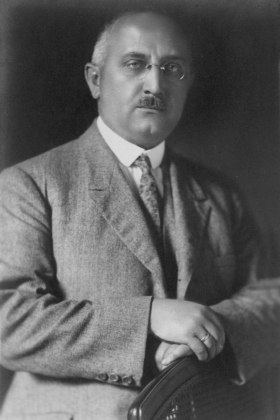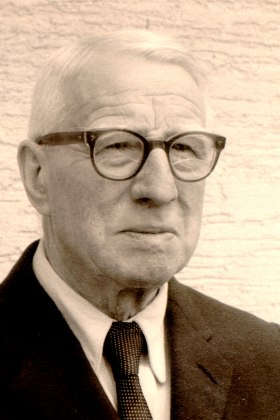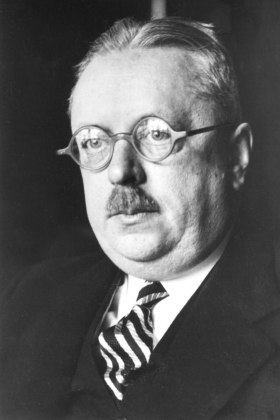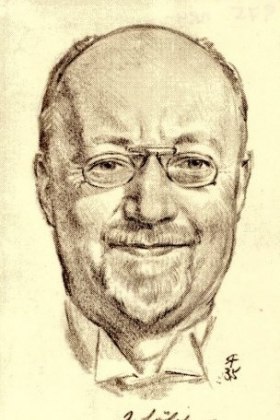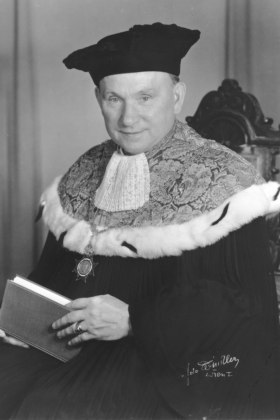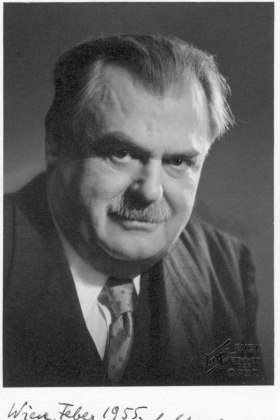The rectors’ plaque in the University of Vienna’s main building on the Ring
The names of all rectors since the university’s founding in 1365 were chiseled into marble in the right side alcove in the aula of the main building at the Viennese Ringstraße in 1892. These rectors’ plaques in the aula – formerly called rectors’ fasti based on the Roman fasti consulares (marble plaques for the highest magistrates on the Capitoline Hill) – with their long list of names of elected university presidents, convey a sense of continuity and stability over many centuries. Across all actual breaks it remains as a symbol of the university’s unbroken independence and represents its – real or idealized – autonomy in choosing its own leader.
Together with the commemorative plaques of the faculties, the Rectorʼs plaque was intended to illustrate the venerable past and present of the University of Vienna, as rector Adolf Exner emphasised a few months before the opening:
“A monumental niche dedicated to the history of our university will be erected under the magnificent gate hall: it will contain, in a noble architectural setting on a series of marble plaques, the main events of its 500 years of existence, plus the complete series of names of its rectors, and moreover, in special places, the memory of its deceased students who have achieved excellence in any field of life since the last century. The work will be ready next spring […] – a testimony to everyone who comes to us that it is not a creature of the day before yesterday that welcomes him, but the oldest university on purely German soil, a venerable tree whose trunk has remained green in good and bad days, and although at times merely vegetating, it still bloomed and bore fruit time and again.”
(Adolf Exner: Bericht über das Studienjahr 1891/92, 24 October 1892, p. 20)
In the fall of 1884, when the construction on the main building was finished, the Academic Senate established a permanent artistic commission with the task of artistically decorating the building. Following archeologist Friedrich August Otto Benndorf and the theologian Wilhelm Anton Neumann's suggestion, the installation of honorary plaques for the faculties as well as a rectors’ plaque (“Fasti of the Rectors”) was decided on December 9, 1890. As a site for the plaque, the Academic Senate chose an “alcove of the vestibule vis á vis the porter’s lodge” on May 13, 1892, in place of a “blind door”. On May 24, 1893, the fasti were unveiled. The names were based on a list compiled by university archivist Karl Schrauf. In 1892/93, 783 names since the university’s foundation were known – today there are 873 entries, the last of which being Georg Winckler in 2011 and Heinz W. Engl in 2022. In the meantime, at least two names of medieval rectors have been found that are missing from the list: Luderus de Palude (1368) and Bertholdus de Wehingen (before 1377).
Above the list is an “introductory” Latin text, written by archivist Schrauf. It names the milestones in the university’s history until the main building’s opening considered relevant at the time:
ALMA MATER RVDOLPHINA | 1365 D. XII. MART. A RVDOLPHO IV. DUCE AVSTRIAE | APPROBANTE VRBANO V. P. M. FVNDATUR. | 1384 AB ALBERTO III. DVCE AVSTRIAE FACVLTATE THEOLOGICA | EX AVCTORITATE VRBANI VI. P. M. RENOVATVR | 1385 PRIMVM LEGES SIBI STATVIT | 1533–54 A FERDINANDO I. ROM. REGE REFORMATVR | 1622 A FERDINANDO II. ROM. IMP. SOCIETATI IESV COMMITIITVRI | 1749–83 IMP. MARIA THERESIA ET IOSEPHO II. REI PVBLICAE REDDITVR | 1849 AB IMP. FRANCISCO IOSEPHO I. LlBERIS LEGIBVS NOVISQVE | SEDIBVS ORNATVR EIVSDEM AVSPICIIS IN DIES MAGIS FLORENS | 1884 HANC AMPLISSIMAM DOMVM ACCEPIT
The rector’s seal as a means of authentication was installed as a decorative sculpture (motif of the university crest: upwards oriented hand with sleeve ruffle, holding an open book, in an upside down trefoil – not identical to the seal used as a logo today).
Handling of National Socialist rectors
Since the unveiling of the rectors’ plaques, the name of each new rector was engraved after the end of his tenure in a Latinized version with the inclusion of his time in office, once for every period in office, so several times if he was reelected. The years from 1936 to 1945 are an exception: In the National Socialist era, this ritual was not continued, which is why both of the two last rectors from Austrofascism, Leopold Arzt and Ernst Späth, as well as the rectors during National Socialism, Fritz Knoll, Eduard Pernkopf and short-time rector Viktor Christian were not included on the plaques. Ludwig Adamovich, the first rector of the post-war period, immediately decreed in May 1945 that his Austrofascist predecessors were to be added, but the National Socialist ones were to be omitted, because they had not been elected by the university, but appointed by the Reich Ministry of Education in Berlin. On June 22, 1945, he decreed: “The names of the N.S. rectors put in place by the Reich Ministry of Education, Prof. Dr. Fritz Knoll and Prof. Dr. Eduard Pernkopf, are NOT to be added to the rectors’ plaque”.
After the end of his tenure in 1948, his successor, rector Johann Sölch, decided to not yet add the National Socialist rectors to the plaque out of respect for the allied occupying troops, but to leave two lines free for them and engrave rector Adamovich’s name underneath this space.
At the first Senate meeting of his term of office on 11 October 1949, Rector Richard Meister initiated the addition of the names Knoll and Pernkopf at the same time as the name of his predecessor Wolfgang Denk. However, the Senate decided to wait and see:
“With regard to the inclusion of the names of the rectors from the period 1938 to 1945 on the rectorsʼ plaque, it is requested that the names KNOLL and PERNKOPF not be included, as they were not elected but appointed rectors. Instead, the note ‘After regaining academic freedom’ should be added. […] The Senate decides to postpone this item in order to give the members of the Senate the opportunity to consider this proposal accordingly.”
On the initiative of exposed former National Socialists organized in the Vereinigung Freiheitlicher Akademiker (Association of Liberal Academics), this meaningful gap was filled ten years later – in 1959 – and the names of the rectors under National Socialism were engraved in the honorary plaque. The then rector Erwin Schneider, professor of Protestant theology, reacted to a note in the German-national magazine “Eckartbote – Deutscher Kultur- und Schutzarbeit”, which read:
"After more than 20 years it is high time to insert the names of the rectors between 1938 and 1945 in the aula of the University of Vienna. | It may be true that during the “Third Reich” the highest honor of the University of Vienna was handed out based on other criteria than has otherwise been the case at the Alma Mater Rudolphina. We understand that one might not have been in a hurry after 1945 to use the little bit of gold dust that apparently was lacking during the war. All the same, anatomist Pernkopf, for example, was a renowned scientist, and more than 20 years after Friedrich Knoll’s accession to the title it should finally be possible to bury the hate, resentment and envy and to fill an empty field with letters of remembrance. Maybe the current rector, Protestant theologian Schneider, is the man most destined to be conciliatory and to bring change, because a void speaks louder than a field on an honorary plaque that has long been made timeless through many newer names. | R.H."
Schneider distanced himself from some of the note’s arguments, but explained in detail in his answer how such a demand needed to be phrased and justified to find success. Quickly, a formal request with exactly these arguments and wording was submitted. Among its signatories were many exposed National Socialists that had at that point already been reintegrated into high offices in society, such as the surgeon Univ. Prof.Leopold Schönbauer, for whom the “Minderbelasteten-Paragraf” (“paragraph for less incriminated persons”) was added to the Verbotsgesetz (the law prohibiting National Socialist activities) and at whose clinic forced sterilizations were done during National Socialism. Other notable signees were the university professor for physical exercise Erwin Mehl (1903–1984), as well as National Socialists fired from the University of Vienna, such as Prof. Dr. Helfried Pfeifer (1896–1970), a member of parliament from 1949-1959 for the WdU/FPÖ, or the National Socialist rector of the Technical University, electrical engineer Prof. Dr. Heinrich Sequenz (1895–1987). The decision to add the names was made unanimously by the Senate on June 27, 1959 – formally not because of the demands of these “bearers of culture” (these kinds of people had been suggested as signatories by Rector Schneider), but “completely separate from this matter”. The names were engraved during the summer break, when no students were present, and under explicit avoidance of media attention.
Art installation „Rektorenfasten – ins licht gerückt“ 2017
As early as 2014, the Forum “Contemporary History of the University of Vienna” (Andreas Huber, Katharina Kniefacz, Herbert Posch, Friedrich Stadler) compiled a report on behalf of the rectorate on the problematic nature of this memorial, which also pointed out that not only the “Nazi rectors2 Knoll and Pernkopf should be viewed critically, but that a total of around 30 people were categorised as at least worthy of discussion due to their involvement in Austrofascism or National Socialism. After the uncommented Rectorsʼ plaque was publicly criticised several times during the 650th anniversary of the University of Vienna in 2015, the rectorate of the University of Vienna decided to initiate a critical commentary.
Information regarding the art project „Rektorenfasten - ins licht gerückt“ by Bele Marx & Gilles Mussard 2017
-
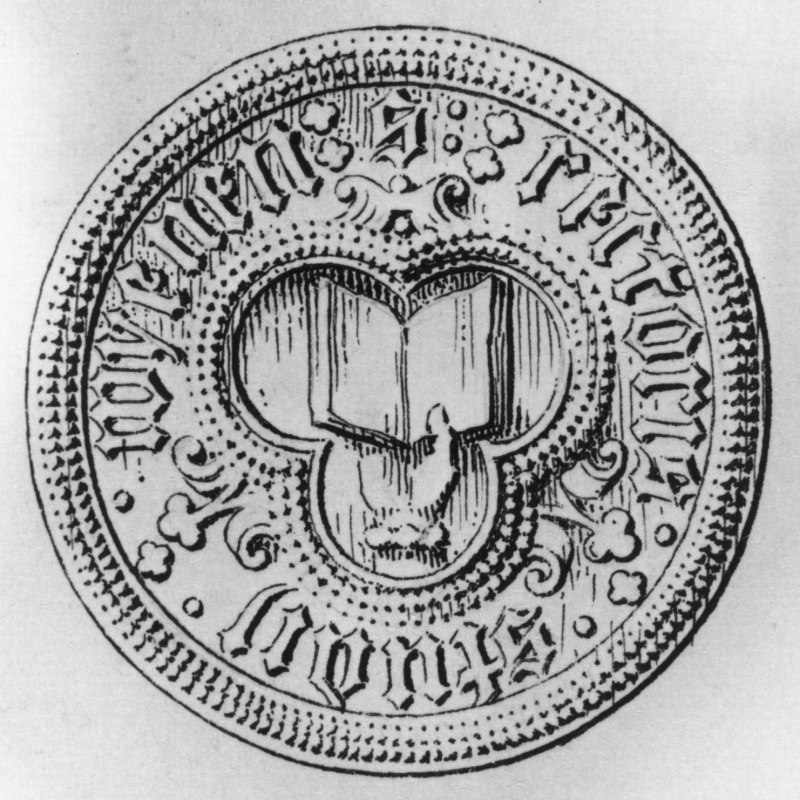
Seal of the rector of the University of Vienna (about 1384), drawing
Rektorssiegel, erstmals erwähnt 1384. Im gotischen Dreipaß wachsende, ein offenes Buch haltende Hand. Umschrift: S(igillum):Rectoris:Studii Wyenen(...
-

The introducing inscription of the rectors’ plaque (“Rektorenfasten”) in the main building of the University of Vienna
Der Text der Inschrift stammt vom Universitätsarchivar Karl Schrauf . Darin werden die wichtigsten Daten der Wiener Universitätsgeschichte als...
-
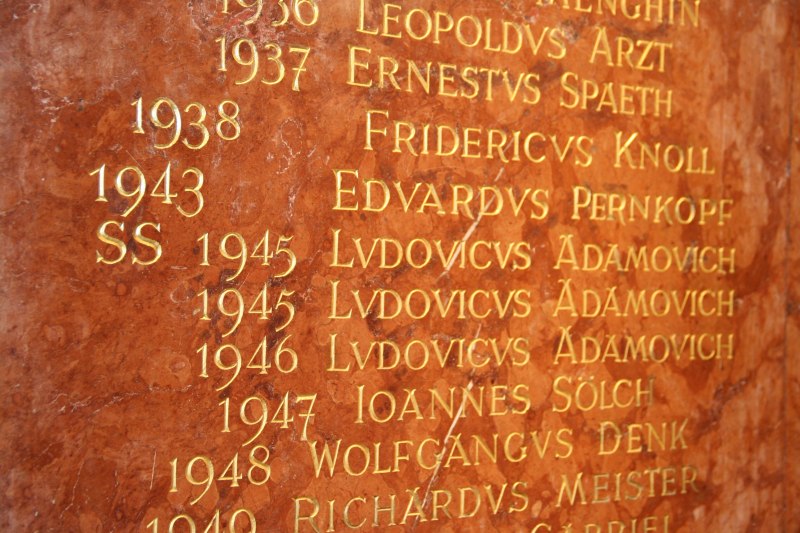
Rectors’ plaque, detail 1937–1948
Rektorennamen 1937-1946: Leopold Arzt , Ernst Späth , Fritz Knoll , Eduard Pernkopf , Ludwig Adamovich , Johann Sölch , Wolfgang Denk , Richard...
-
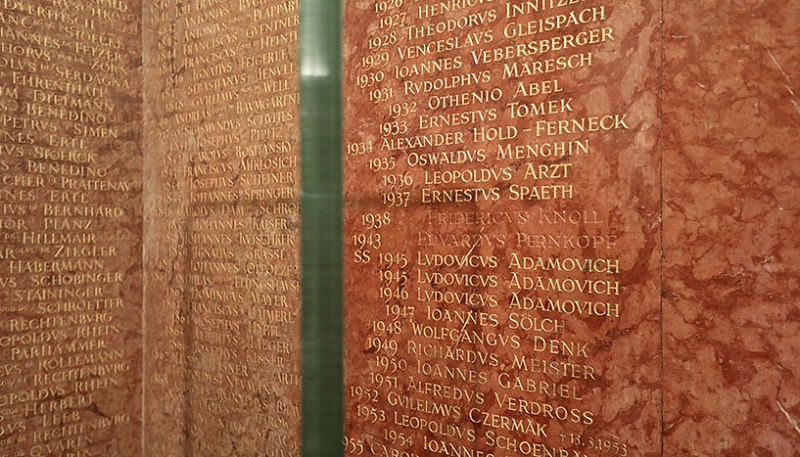
The chiseled names of the “NS-rectors” Knoll and Pernkopf after the removal of the gold-plating, Kunstinstallation “Rektorenfasten – ins licht gerückt” (artists: Bele Marx & Gilles Mussard), 2017
-
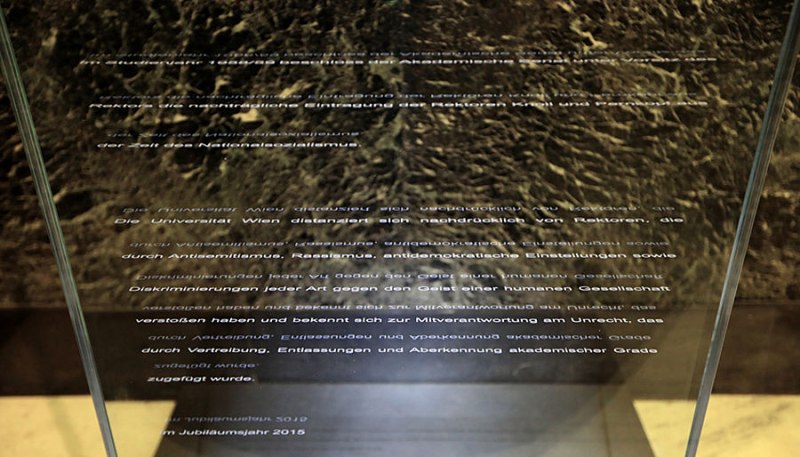
Text of the glass stela in front of the rectors’ plaque, “Rektorenfasten – ins licht gerückt” (artists: Bele Marx & Gilles Mussard), 2017
"Im Studienjahr 1958/59 beschloss der Akademische Senat unter Vorsitz des Rektors die nachträgliche Eintragung der Rektoren Knoll und Pernkopf aus...
Last edited: 03/05/24








